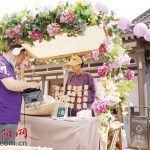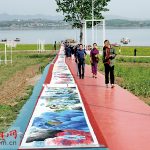
Recently, the Henan Archaeological New Discovery Forum was held in Zhengzhou, and the site of Xiangshan Temple in the Tang Dynasty in Longmen, Luoyang, announced the latest archaeological excavation results.
Longmen Xiangshan Temple is one of the famous “Longmen Ten Temples” around Longmen Grottoes in the Tang and Song dynasties, and is a royal temple in the Tang Dynasty, located at the southern foot of Dongshan in Luoyang Longmen Grottoes. The existing area of the site is more than 40,000 square meters, and from 2016 to 2023, an archaeological team jointly formed by the Longmen Grottoes Research Institute, Peking University and Luoyang Institute of Archaeology has excavated 4,000 square meters.
Archaeologists found two square building foundations (No. 1 and No. 2) in the site, both of which were tower foundations. In the middle of the foundation of Building No. 1 is a semi-crypt ruin, which contains a burial space for relics. The remains of the No. 2 brick structure are brick towers with the function of burial, and experts preliminarily infer that the age is the late 7th century, and the burial person is the Tianzhu monk Di Bohara who entered the Tang Dynasty.
“Di Bhahara is the earliest Tianzhu (ancient Indian) monk buried in Luoyang in the Tang Dynasty, and this excavation is also the first excavation of the tomb tower of Indian monks in the Tang Dynasty.” Lu Wei, director of the History and Humanities Research Center of the Longmen Grottoes Research Institute, introduced that the relics unearthed at the site of Xiangshan Temple are rich in types, including handprint bricks, relics stone letters, stone slabs, Buddhist statues, porcelain fragments, lotus pattern tiles, Tang Dynasty copper coins, stone building components, Song Dynasty travel monuments, etc.
These relics and relics are not only of great significance for the discussion of the layout of Xiangshan Temple, its historical evolution and its relationship with the drum platform area, and cultural exchanges between China and foreign countries, but also provide important basic information for the in-depth study of the relationship between Longmen Grottoes and the surrounding temples and the layout of Buddhist temples in the Middle Ages in China, and accumulate experience for the architectural archaeology of Chinese Buddhist monasteries. (Luoyang Daily Financial Media Luoyang Net Reporter Wisdom Picture for archaeological data)








